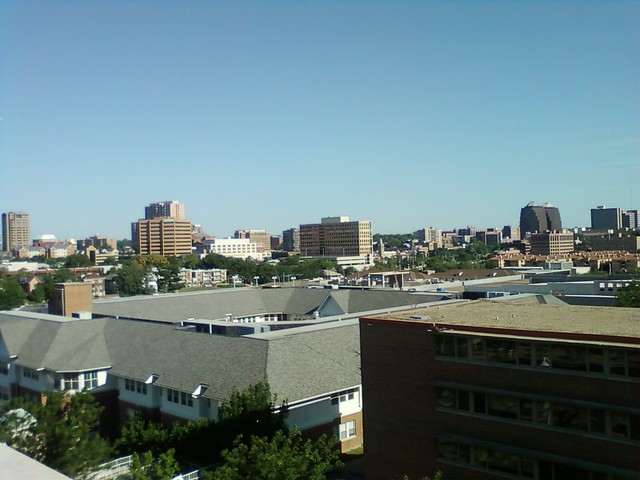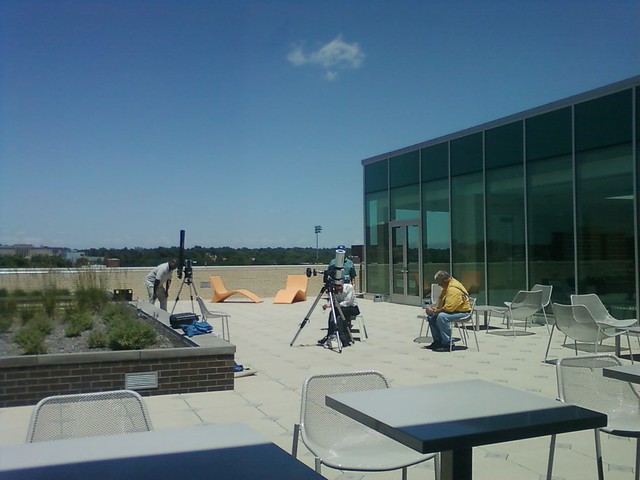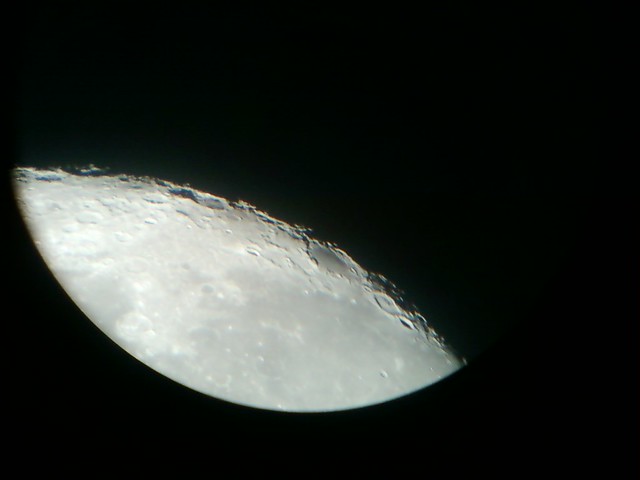
I survived the second day of the MSRAL convention. I think I overdosed on science, as my brain worked overtime while I slept to process the fascinating concepts, breakthroughs and forthcoming projects in astronomy and astrophysics I absorbed Saturday.
I arrived just in time to wait for the business meeting (scheduled for the eight o’clock hour) to run over into the first session. I strolled around the fourth floor of the UMKC Student Union, watching the venders setup their tables in the room adjacent to the main conference one. Several conference attendees also brought their solar telescopes and began setting them up on the rooftop deck of the building to facilitate solar observing throughout the entire day (and we had crystal clear skies for the duration).
Morning sessions:
- History of U.S. Astronomy and funding forecast, presented by Dr. Dan McIntosh, who kindly provided a link to his entire presentation during his talk: U.S. Astronomy: Past, Present and Future. Some highlights from my notes:
- I need to watch The Journey to Palomar via PBS’s website.
- NSF founded/funded in 1950
- NASA founded/funded in 1958
- Public investment in science led to a boom in our economy.
- In the 20 year history of the Hubble Space Telescope (HST), more than ten thousand (10,000) scientific papers have been published.
- Out of our huge $3.7 trillion federal budget, only 0.85 percent of it relates to science funding (NSF, NASA, DOE, etc.) or about $60 per year per family.
- Is Science a Good Investment? It inspires dreams, drives innovation, new technologies (just a few of NASA’s 6,000 patents and 2,000 spinoff ventures: water filters, cordless tools, shoe insoles, memory foam, scratch resistant lenses, UV sunglasses, cell phone cameras), which lead to economic growth and we, the public, come to rely on the new technology (GPS, weather, communication satellites).
- Local amateur astronomer discovers comet (skipped most of this session because I saw it at a club meeting in March).
I returned to the stairs leading from the third floor to the top floor of the Student Union for the group photo just before we broke for lunch. I ended up standing in the second row directly behind Fred Bruenjes (see local comet discoverer mentioned above).
Afternoon sessions:

- Helioseismology leads to Asteroseismology via the Kepler satellite aka Twinkle, Twinkle Little Star: The End of Wondering in the Era of Asteroseismology. presented by Dr. Bruce Twarog. This session really stretched my flabby scientific brain muscles. The professor presented his topic with great enthusiasm. I took copious notes, because I knew I needed to research and review most of what he talked about. The first portion of his talk dealt with some history, including a crash course in Fourier transforms. Once we were all on the same page, he could talk about helioseismology. Finally, we connect the dots of how the data gathered by the Keppler Mission can build upon our discoveries in our own sun and apply them to other stars in a leading edge branch of astronomical research called asteroseismology.
- Webcam Imaging by David Kolb: Interesting, but it seems like an awful lot of post-production work involving a myriad variety of software packages. I will learn more this morning during a workshop with this presenter.
- Another interesting topic, where paleontology was used to find our Nemesis (or not), presented by Dr. Adrian Melott and I even found the publication from 2010: Nemesis Reconsidered
- NASA’s Night Sky Network – There actually is an app for that (stargazing that is). All these tools, kits, videos and services provided free by NASA to astronomy clubs around the country.
Evening Keynote: LSST by Dr. Barbara Anthony-Twarog. Wow, just wow. This telescope, when it becomes operational (currently proposed completion and operational in 2022), will survey the sky like never before. All the data (15 terabytes per night) will be freely available to everyone (not just the US public, but the entire world). By the time it finishes its ten year run, there may be nothing left for traditional observers (both professional and amateur astronomers alike) to discover. The future of astronomical research will no longer rely on observations, but will need computer scientists and data miners to sift through the avalanche of data produced by the LSST.

After Dark: Warko on the rooftop of Royall Hall
I moved my vehicle from the parking lot next to the Student Union to the parking garage next to Royall Hall, parking on the fourth level to take the sky bridge across to the building and then a couple of flights of stairs up to the rooftop observatory. The nearly full moon shone exceptionally bright on a clear, calm evening. We trained the 16 inch telescope on it, at least until the sky darkened enough to move on to other targets. I snapped a quick photo with my cell phone of the bright moon through the eyepiece:
We moved on to Saturn and stayed there until I had to leave (around 10:30) because I had a forty minute drive home and had been up since five.
I saw my first iridium flare last night. What is an iridium streak, you ask? Check out the Heavens Above web page to find out and to search for a streaker in your neighborhood (sky that is).
I enjoyed my second day at the convention. I learned more than I can possibly absorb on just five hours of sleep. In just a few minutes, I return for the final half-day of workshops. I’ll post my final thoughts later this afternoon, perhaps after I’ve had a nap.


